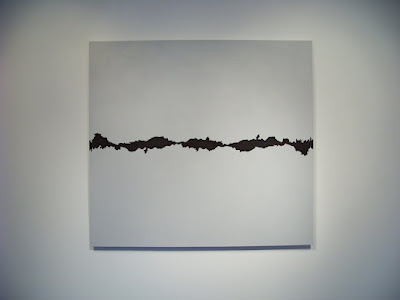SOLO SHOW: Sümer Sayın | Bir an için / For a moment @ Art ON | 28.01.2012, 18:00







Umut ve Entropi
Sümer Sayın'ın işlerinin bütünü çoğu zaman sanatla ilişkilendirilen durağanlığa direnir ve harekette var olur. Mesafeleri aşan değil ama kendi etrafında dönen ve yinelenen bir harekette… Durumlar ne kadar uçucu ya da ne kadar kaotik olursa olsun, döngüsel yinelemenin davranışı iyileştirme gibi bir niteliği de vardır. Birden çok elemanın belli bir noktaya kadar tahmin edilemez aralıklarla hareket edişinin izlerini saptamak, bu elemanlar asla son bir pozisyon almasa bile izleyicinin beklentiler geliştirmesine izin verir.
Bu fikirler sanatçının iki metre genişlikteki kinetik heykeli YES'te beliriyor. Entropik bir aktivite üreten bir grup köşegen form gri bir ahşap konstrüksiyon üzerinde ılımlı, belirli bir kargaşa yaratırken, bu sürecin şaşırtıcı ve kısa bir anında, herşey yerli yerine oturduğunda birbirinden bağımsız elemanlar hizaya geliyor ve nihai olumlamayı meydana getiriyor. Harfleri meydana getiren elemanlar dijital saat veya işaretlerdeki segmentler gibi görünüyor. Heyecanlı olmaktan ziyade robotik bir şekilde, kaosun içinden çıkan az ve öz bir onaylama eninde sonunda düzensizliğin içinde parçalanıyor. Bir nikahtaki gelin gibi sizi sihirli kelimenin belirmesi için bekletmek istiyor.
Ama bu kesinlik sözleri aceleye gelmiyor. Sergideki diğer bir eser, 4 adet başına buyruk dönen harften oluşuyor. Bir araya geldiklerinde geçici olarak EVER kelimesini oluşturuyorlar. Sonsuza dek oluş halinde olmak ve olmaya devam eden EVER. NOW kelimesini oluşturan daha önceki bir işin devamı. Aslında, bu üç işte ortak olarak bulunan şey estetikleri, sergileniş biçimleri ve yapısal kompozisyonlarının dışınnda kelimeleri biçimsel ve anlamsal olarak manipüle etmeleri.
Sanatçı yıkımsal ilgisini sadece kelimelere yöneltmiyor. Klasik Taocu sembolü olan Taijitu, yaygın olarak yin yang sembolü olarak bilinen birbirini tamamlayan güçlerin dinamik etkileşiminde ulaşılan dengeyi temsil eden ''yüksek üstünlük diagramı''nı Balance başlıklı video loop'u için yapıbozuma uğratarak parçalarına ayırıyor. Siyah ve beyaz, şeker renklerinde bir fon üzerinde zıt yönlerde hareket ediyor. Şekil son derece düşük bir tempoyla dönerken yavaş yavaş ortadan ikiye bölünmüş garip birleşim yerleri ve bölümleri olan yarısı beyaz yarısı siyah bir daireye dönüşüyor. Eski ekran koruyucu estetiğini ödünç alsa da, bu işin 1926 Duchamps filmi Anemic Cinema ile daha eski bir atası var. Burada roto-rölyefler hareket halinde gösterilirken, döndüğünde bir vertigo hissi yaratacak şekilde tasarlanan çizimler, anlamı belirsiz kelime oyunları ve aforizmalarla kesişirken izleyicinin hayalgüçlerini harekete geçiriyordu.
Sayın'ın kesinliği ele alış şekli de faklı bir tür vertigo yaratıyor, ve bir çok yönüyle kaostan gelip, rastgele, kısa ve uçucu bir şekilde belirirken anlamdan saçmalığa doğru yol alıyor. Kesinlik bu şekilde geldiğinde her seferinde bir insanda bir iz bırakabilir ve umut uyandırabilir, tabii berrak anlar biraz daha uzun sürebilseydi.
Andreas Schlaegel
Hope and Entropy
Much of Sümer Sayin’s work resists the stasis often associated with art; it exists in motion —not to cover distance, but in rotation and in loops. A loop has a specific quality in that its repetition can condition behavior, no matter how volatile or chaotic the circumstances are. Detecting traces of a loop in a situation of multiple elements that move with more or less unexpected intervals allow the viewer to build up expectations —even if things never assume one final position.
These ideas reverberate in the artist’s piece YES, a 2 meter wide kinetic sculpture. Producing entropic activity, a mob of black rectangular forms rotate on a grey wooden construction, creating a kind of moderate, determinate havoc until, in one surprising and brief moment of this process, when things just click, and everything seems to make sense, the individual elements align and form the ultimate affirmative. The individual elements that make up the letters look like segments in digital watches or signs. It is robotic instead of enthusiastic; a laconic confirmation emerging from chaos that eventually disintegrates into disorder. Still, it makes you want to wait, like a bride at a wedding, for the magical word to appear.
But these words of certainty take their time. Another piece in the show consists of four complete letters rotating individually. When they converge, they temporarily form the word EVER. Forever becoming as well as being, it is an extension of an earlier piece that forms the word NOW. However, what these three pieces have in common, is not only their aesthetics, reminiscent of official displays, and structural composition, but their formal manipulation of the words and their meanings.
The artist does not limit her subversive interest to words alone. In her take on the classic taoist symbol Taijitu, the "diagram of the supreme ultimate" (commonly known as the yin & yang symbol), that signifies a balance achieved in dynamic interplay of opposing but complementary forces, she deconstructs it for her video loop Balance, taking apart the components —the white and black move in opposite directions and are set in motion against a background of candy colors. As it rotates at a painfully slow pace, it gradually transforms into a circle that is divided right down the middle, half black, half white, with awkward intersections and segments. Even if it borrows the aesthetics of obsolete screen saver graphics, this work has a much earlier ancestor in Marcel Duchamp‘s 1926 film Anémic Cinéma. This shows his “Roto-Reliefs” in action, drawings on discs that were designed to evoke a sense of vertigo when spinning. Intersected with rather ambiguous puns and aphorisms, they fuel the viewers‘ sense of imaginative conjuration.
Sayin’s take on the absolute creates another sense of vertigo, and in many aspects, the absolute comes from chaos, appearing haphazardly, briefly and fleetingly, moving from sense to nonsense. But when it does, and every time it does, it can leave a mark on an individual, and inspire hope, if only the moments of clarity would last a little longer.
Andreas Schlaegel





Comments